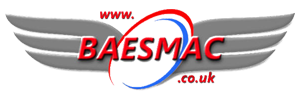Failsafe Setting and Checking for Models Flown at BAE MAC Flying Sites
Until the advent of 2.4GHz radios the setting of automatic radio failsafe settings was the preserve of PCM receivers or additional dedicated Failsafe Units. Now many people have 2.4GHz set ups, which ALL have failsafe provision (in various guises).
Whilst failsafe (throttle to idle as a minimum) MUST be set for some types/sizes of model (i.e. ANY Turbines or models over 7Kgs) and SHOULD be set for any models that are in the BAE MAC ‘Vetting’ Category (vetters will encourage the modeller to use a throttle failsafe device if on 35MHz PPM), it SHOULD also be set on ANY MODEL where there is the capability.
Extract from the BMFA Handbook Below:
FAILSAFE
(a) CAP 658 says: For All Model Aircraft
Any powered model aircraft fitted with a receiver capable of operating in failsafe mode (i.e. PCM receivers, Digital Signal Processing (DSP) receivers or 2.4 GHz equipment) should have the failsafe set, as a minimum, to reduce the engine(s) speed to idle on loss or corruption of signal.For Models Weighing 7 to 20 kg
A serviceable ‘fail-safe’ mechanism should be incorporated to operate on loss of signal or detection of an interfering signal. For example on a power driven model this should operate, as a minimum, to reduce the engine(s) speed to idle.For All Gas Turbines
All gas turbine models should be fitted with a failsafe. This must bring the engine to idle in the event of radio interference or failure. The fuel system must be capable of manual shut off via a fuel valve or fuel pump switch.
Note: The current CAP 658 does not mention that 2.4 GHz equipment has failsafe modes built in but it would not be sensible to have this section in the Handbook without making reference to the fact.(b) This means that you will have to carefully consider what type of receiver you are using in ANY i/c or electric powered model, even the smallest. All PCM sets, most DSP 35 MHz receivers and all 2.4 GHz equipment have settable failsafe modes and if you are using any one of these then you should take care to set the failsafe to at least engine idle.
For over 7 kg, you should ONLY use failsafe settable equipment and, again, set to engine idle as a minimum.
(c) As a reminder, nearly all PCM and DSP receivers and all 2.4 GHz equipment defaults to ‘hold last position’ out of the box so if you don’t set the failsafe, then that’s what it will do. This means that, for even the smallest model, interference or loss of signal will mean throttle and control lock-on and a potential flyaway or high throttle, high energy impact.
(d) Users of any failsafe capable radio equipment (PCM, DSP or 2.4 GHz) should check fail-safe operation before each flight. With the model restrained, switch off the transmitter and ensure that all relevant controls on the model move to their preset fail-safe positions. Switch the transmitter on again and make sure that normal control operation returns within a few seconds. If the fail-safe does not re-set quickly there may be a fault so DO NOT FLY.
To be safe, You must take the positive step of specifying what your failsafe should do instead of leaving it set at default. Read your radio manual carefully for details of settings. If you don’t initially understand the instructions for setting the failsafe on your equipment then you MUST take steps to find out how to do it. This is one thing you cannot ignore and ignorance of the procedure is not an excuse that can be accepted.
Note: If you have PPM equipment and don’t have a DSP receiver but are using an add-on failsafe, it too should be set as a minimum to low throttle.
Glider Fail safe for Models Weighing 7 to 20 kg
The requirement in CAP 658 to use and set failsafes applies to these silent flight models too, although obviously the ‘setting of throttle’ does not apply. You should remember that the reason that the CAA requires failsafes is to prevent flyaways, not to deliberately crash the model, and you should set the controls of your model with this in mind. Application of spoilers, ‘crow’ brakes or even rudder and elevator to spin the model might be appropriate.
Note: for JR and Spektrum users (DSM2 and DSMX receivers), where the failsafe is set on Binding the Tx to the Rx IT IS ESSENTIAL that on completion of a model set up that the Rx is REBOUND to ensure that the throttle channel is correctly set to idle on loss of signal. This ‘may’ also be true of other manufacturers. It is YOUR RESPONSIBILITY to know how your equipment works
The BAEMAC operates on flying sites that are part of the BAES Infrastructure and therefore have a large number of high value assets and buildings. As a result we have strict areas to maintain model flying activity within.
Therefore setting failsafe (and checking it’s operation) on ALL equipment, where it is possible, is essential.
